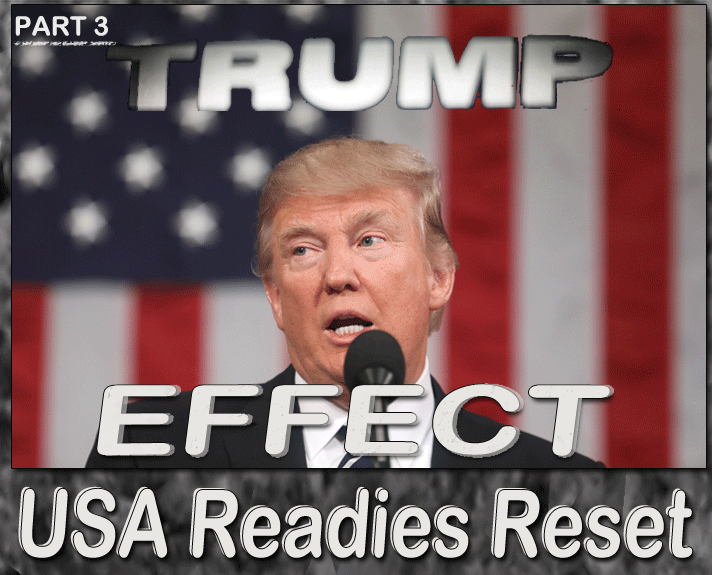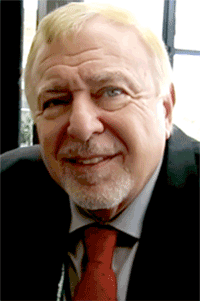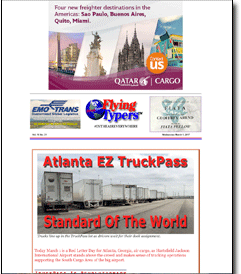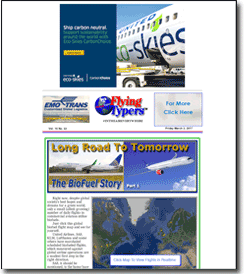
After
145 years, Ringling Brothers and Barnum
& Bailey Circus will close at
the end of this season because animal
welfare activists have successfully
complained about the mistreatment
of their elephants.
This
circus has been called the “Greatest
Show On Earth.”
Now
President Trump’s Trump Effect—led
by the Republican Party, whose branding
symbol is an elephant—has been
labeled “The Greatest Show On
Earth” by the New York Post.
FlyingTypers
Set The Tone
One personal note: I must commend
Geoffrey Arend and his wife, Sabiha,
for creating the headline The Trump
Effect.
Trump
Effect is now being used globally
when describing the actions and effects
of President Trump’s administration,
but those words appeared in FlyingTypers first.
Unfortunately,
Geoffrey and Sabiha are not getting
the credit they deserve for coming
up with this headline.
But
I am happy to report that being the
true professional journalists that
they are, both seem too busy covering
air cargo worldwide to care much about
taking a bow.
Donald
Trump So Far
My message should not be considered
political, but rather as an effort
to look at the possible effects of
the actions being proposed by the
Trump administration on the airline
industry. I have purposely not said
what actions I would take, as that
is a decision each airline needs to
carefully consider.
As
I said in past articles, President
Trump has said he is committed to
3 major items, which was voiced again
in his recent speech before the joint
session of congress. These are the
security of the U.S., a fair balance
of trade to grow jobs in the U.S.
fueled by tax, regulatory, health
care and education reform to make
U.S. products globally competitive,
and the rebuilding of U.S. infrastructure.
All
these policies will affect the airline
industry in one way or another, and
if President Trump accomplishes his
agenda the big question is whether
global economies will benefit.
The
Promise & The Hope
The promise of President Trump to
eliminate terrorism and stop nations
and organizations bent on attacking
neighbors who don’t conform
with their ideology will increase
U.S. business and the U.S. airlines
CRAF flights over the short term,
but in the long term, if successful,
it will reduce the funds channeled
into those military and protective
areas. My personal hope is that this
money will go towards manufacturing
improvements to help humanity and
funding research to cure diseases
and not just “treat” them.
Both
outcomes will increase business for
the airline industry.
On
a personal note, I hope President
Trump accomplishes this goal not just
through military action, but also
through humanitarian and nation building
efforts, and as he said in his speech
before congress, that the U.S. keeps
its word with those people who risked
everything to gain peace.
If
the President accomplishes this, the
winner will be all of us who live
on planet earth. Hopefully world peace,
improved education, and medical care
will lead to prosperity for all of
humanity.
As
Shakespeare’s Hamlet said “To
die, to sleep – to sleep, perchance
to dream – ay, there's
the rub, for in this sleep of death
what dreams may come…”
To
Grow U.S. Economy
The second goal of President Trump
is to grow the U.S. economy and to
restore it to its previous post war
levels. This will have many parts
to it.
The Trump Effect will attempt to
pass legislation to encourage more
products made in the U.S. be sold
in the U.S. The strategy is to create
more jobs, less unemployment, more
disposable income, and increased consumer
spending.
But
can all the components for these manufactured
goods be made in the U.S.? I think
not.
That
may be why President Trump is concentrating
on bilateral trade agreements so that
the flow of goods in and out of the
U.S. by selective tariffs can be better
controlled and countries that put
high tariffs on U.S. goods can be
treated the same on their imports
into the U.S.
At
the same time, Investment Tax Credits
may be given to increase the efficiencies
and quality of U.S. manufactured items,
and then retrain the workforce for
these more skilled higher paying jobs.
Coupled
with the promise of significant tax
cuts and lower health care costs,
more disposable income could be created
to buy these goods.
Stock
Market At 30,000
With the predicted increase of the
U.S. dollar and the NY stock market
growth to what some experts say will
hit 30,000, The Trump plan would lead
to manufacturing growth and a significant
increase in the flow of air cargo
goods to and from the U.S. to those
bilateral trade partner countries,
establishing increased trade flows
between the other countries.
Imagine
A New World
If President Trump can do all this
and lower the cost of U.S.-manufactured
finished goods to be competitive through
tax reductions and economy of scale
with a focus on quality and the expansion
of new technically advanced manufactured
items, the Trump Effect could very
well create a large global market
for U.S. manufactured goods and parts
carried by air.
Trading
Partners
Now, who will those trading partners
be? As I said in earlier articles,
the airlines that predict the Trump
Effect right and adjust their schedules
and tariffs accordingly will be huge
winners.
About
The Deficit
The trade deficit in the United States
was USD 502.25 billion in 2016, at
the highest annual level since 2012
and a 0.4 percent increase from 2015’s
gap of USD 500.36 billion. Exports
rose 2.7 percent, boosted by higher
sales of U.S. civilian airplanes and
aircraft engines. Imports were up
1.5 percent, including a rise in car
imports.
The
deficit with Mexico rose 4.2 percent
to USD 63.2 billion in 2016, which
is a five-year high.
The
deficit with China totaled USD 347
billion, more than three-fifths of
the overall U.S. deficit. China and
Mexico combined equal about 70 percent
of the U.S. balance deficit in world
trade.
Balancing
of world trade for the U.S. is therefore
highly dependent on these two countries.
Reality
Focus & Things To Come
So, let’s look at the signs
the Trump administration has put out.
President
Trump is looking closely at The North
American Free Trade Agreement (NAFTA),
which is an agreement between the
United States, Canada, and Mexico
designed to remove tariff barriers
among the three countries and increase
trade between them.
The
President stated recently that the
name should be changed to The North
American Free and Fair Trade Agreement
(NAFFTA) and has met with the Prime
Minister of Canada and sent a trade
delegation to Mexico on this subject.
Don't
concentrate on the back and forth
chatter on paying to build a wall
between Mexico and the U.S. as that
will happen for other reasons and
is a distraction from the real goal,
which is balanced fair (and POTUS
said free) trade.
Checking
Numbers
The balance of trade between the U.S.
and Canada is about USD 11.9 billion.
Exports
to the U.S. were $337.3 billion
and imports were $325.4 billion.
Canada
is currently the U.S.’s second
largest goods trading partner with
$575 billion in total (two-way) goods
trade during 2015; obviously, NAFTA
is working there.
So,
President Trump must focus on Mexico
for a fairer balance of trade.
Mexico
is the United States' second largest
export market and the third largest
supplier of imports.
China
Is The Big Kahuna
But the larger target of President
Trump’s effort for balanced
trade to improve the U.S. economy
must be China, where the U.S. has
a USD 347 billion trade deficit.
Results
with China will not be achieved quickly
as negotiations are very critical
between these two world super powers.
However,
NAFFTA (Mexico & Canada) could
become a more reliable source for
goods now being produced in China.
While
China might ponder that point, a rebooted
manufacturing scenario could afford
Mexico and Canada some negotiating
power.
Other
Players
The United States has been running
consistent trade deficits since 1976
due to high imports of oil and consumer
products.
In
recent years, as I mentioned earlier,
the biggest trade deficits were recorded
with China and Mexico, but Japan and
Germany were also among the leaders.
Japan
and Germany are U.S. allies and President
Trump has not mentioned them.
On
the plus side, the United States has
trade surpluses with Netherlands,
United Arab Emirates, and Australia,
which are strategic partners President
Trump has also not mentioned.
Countervailing
Tariffs
One of the tactics that President
Trump has voiced is imposing countervailing
tariffs not just on China, but on
any American trade partner that cheats
on its trade deals using practices
such as currency manipulation and
illegal export subsidies.
Such
tariffs are not protectionist but
rather defensive, and consistent with
actions taken by American Presidents
from George Washington to Ronald Reagan.
Indeed, one of the first bills George
Washington signed was a tariff, which
Alexander Hamilton justified as a
necessary defense against a mercantilist
Europe.
When
Japan flooded global markets with
underpriced computer chips in the
late 1980s, President Reagan slapped
a 100 percent tariff on semiconductors,
plus high-end computers and TVs.
The
total tariffs were based on the economic
injury suffered by the U.S. semiconductor
industry because of Japan’s
cheating on a trade agreement.
This
is the kind of flexible case-by-case
approach that a Trump White House,
Treasury Department, Department of
Commerce, and U.S. trade representative
may likely use in their bilateral
trade negotiations.
The
China Case
China’s state-run industries
significantly undercut foreign manufacturers
and NAFTA.
Studies
show that China’s lower labor
costs accounted for about 40 percent
of China’s price advantage.
China
is the culprit of five other trade
practices that can be labeled as unfair—illegal
export subsidies, currency manipulation,
intellectual property theft, and lax
worker safety and environmental regulations.
For
example, China’s central bank
keeps the yuan undervalued, thereby
over-stimulating their exports while
discouraging foreign exports into
China.
Such
blatant currency manipulation contributed
significantly to the USD 347-billion
trade deficit last year.
Similarly,
when China simply steals the intellectual
property behind U.S. and other countries’
technology and avoids incurring substantial
research and development costs it
gains a huge advantage in key industries
like autos, aviation, avionics, biotechnology,
and pharmaceuticals.
Likewise,
when Chinese companies evade the environmental
and worker safety costs imposed on
American and European industry, made-in-China
stuff can become even cheaper.
The
unfair trade advantages China reaps
from lax environmental and health
and safety regulations are written
in blood.
More
than 60,000 Chinese workers perished
in workplace accidents in 2014 and
world health organization studies
estimate that up to a half-million
people die prematurely because of
China’s horrific air pollution.
Many
experts figure the effects of these
practices artificially lower the price
of Chinese manufactured goods by about
45 percent, which is the exact amount
of President Trump’s suggested
China tariffs.
War
Undeclared
China has been waging an undeclared
trade war on the U.S. since joining
the World Trade Organization in 2001.
The reported U.S. casualties alone
amount to more than 50,000 American
factories shuttered and zero gains
in real household median income.
The
U.S. annual GDP growth rate has been
cut almost in half since 2001 compared
with the last half of the 20th century.
President
Trump has vowed to restore it to 3%
or higher.
The
45% Tariff
Perhaps most concerning of the possible
future action with China, at least
to Wall Street, are possible tariffs
on goods imported from China into
the U.S.
The
current average tariff on imports
from China to the U.S. is about 3
percent, per the U.S. International
Trade Commission.
Some
economists say a 45 percent tariff
could slow China’s economy by
3 percentage points, making the direct
impact on China’s GDP sizable.
The
value added by exports is about 10
percent of China GDP, and the U.S.
accounts for about one-fifth of China
exports.
President
Trump will have some strong negotiating
power.
But
the pain would almost certainly spread
to U.S.-based multinationals that
do business in China as well, unless
President Trump comes up with an alternate.
One idea might be expanding the new
NAFFTA plan to other Central and South
American nations.
Looking
Ahead, Stay Tuned
There are still many other facets
of the Trump Effect to be discussed
ahead, including what will impact
the airline industry (such as Regulatory
Reform); finding ways to train more
qualified pilots to fuel the growing
U.S. airline industry; new technology
research on fuel cells; new aircraft
design development; free flight; the
effect of President Trump’s
meeting with the U.S. Airline CEOs;
the growth in U.S. infrastructure,
etc.
My
future articles will cover these and
many more topics impacted by the Trump
Effect.
We
invite your comments.
Bill
Boesch
 Mr.
Boesch started his career in global
transportation and logistics in
1965 working for Seaboard World
Airlines. He later joined Flying
Tiger Airlines and Emery Worldwide.
Mr. Boesch then left Emery to
become Pan American World Airways’
Senior Vice President where he
headed both Passenger and Cargo
Sales and Operations. He left
Pan Am to lead American Airlines’
Cargo operation and retired from
AA in 1998. Under his direction
American became a world leader
in the air cargo and logistics
business. Mr.
Boesch started his career in global
transportation and logistics in
1965 working for Seaboard World
Airlines. He later joined Flying
Tiger Airlines and Emery Worldwide.
Mr. Boesch then left Emery to
become Pan American World Airways’
Senior Vice President where he
headed both Passenger and Cargo
Sales and Operations. He left
Pan Am to lead American Airlines’
Cargo operation and retired from
AA in 1998. Under his direction
American became a world leader
in the air cargo and logistics
business.
Mr.
Boesch Mr. Boesch was part of
the extensive on site planning
and support of the Iraq drawdown,
involvement with the Afghanistan
operations, and has worked on
all aspects of the Civil Reserve
Air Fleet (CRAF) from both an
airline and government standpoint.
Mr.
Boesch has also served as Chairman
of the International Air Transport
Association (IATA) Cargo Executive
Subcommittee in 1996 and 1997,
Vice Chairman of IATA’s
Cargo Committee. Mr. Boesch served
on the Board of Directors of Air
Cargo Incorporated, Air Cargo
International, The International
Air Cargo Association (TIACA),
Envirotainer, Cargo Logistics
Solutions, Deutsche Post/DHL Global
Mail, al Seqir and consulted for
major U.S. companies including
Flight Safety.
Mr.
Boesch is the recipient of numerous
awards including the Lifetime
Air Cargo Achievement Award, the
Ellis Island Medal of Honor and
various awards from the U.S. Department
of Defense.
Mr.
Boesch is presently continuing
his work for the U.S. Government
and heads up The Council For Logistics
Research. |
To Read Part 1 of This Series,
Click Here
To Read Part 2 of This Series, Click Here
To Read Trump Effect—India Walks
Softly Carries Big Stick, Click Here
To Read Trump Effect—Implications
Of A Trump Trade War, Click Here |





